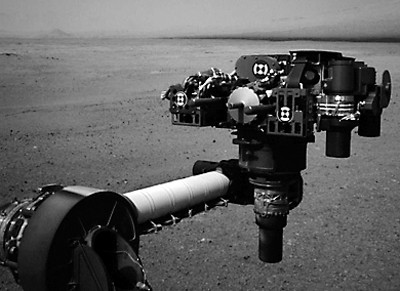What’s Up, Curiosity?
When a sixth-grader in Lenexa, Kansas christened Curiosity, she picked the perfect name for an extraordinary machine. Curiosity spent eight months packed away inside a spacecraft on the 570 million km journey from Earth to Mars. Then she survived 7 seconds of terror to make the coolest landing ever – being lowered from a ‘sky crane’ on to the rocky surface of the red planet’s Gale Crater. But it’s only now that her journey really begins. Curiosity’s nuclear energy source can keep her powered for 14 years – what will she find on Mars?

“There are 70 lbs of science at the end of my arm! Includes a drill, scoop, brush camera & X-ray too.
After the rover touched down on August 6, 2012, Mission Control wanted to make sure everything was in working order. It also spent many hours upgrading the rover’s dual computers. In the days that followed, tests were run – were all 10 instruments in working order? Could the rover move around comfortably? A picture sent back from Mars confirmed she could.
It’s also been a great opportunity for JPL engineers to learn how to manoeuvre Curiosity’s robotic arm. The arm is 2m long and weighs in at 30kg!
Curiosity also has the coolest (and most powerful) laser ever to be sent into space. She practiced using it on a
fist-sized rock dubbed ‘Coronation’ – also known as Martian rock N165 – zapping it30 times over 10 seconds with 14 millijoules of energy in each pulse from 10 feet away! Curiosity’s ChemCam (short for Chemistry and Camera) then took pictures of the resulting glowing, ionized gas, allowing it to identify chemical elements in the rock.
They need to make sure everything is working just right because ahead of Curiosity lies a truly demanding journey – trundling forward at 1.5 inches per second (and slower if the ground is uneven) she’ll have to make her way to Mount Sharp which rises 5.5 kilometres above the floor of Gale Crater.
The 7-km trek will take many months but the six-wheeled Curiosity first plans to take a little detour to Glenelg. The new site is 1,300 feet east-southeast, and scientists picked it because it boasts three types of intersecting terrain that would be great subjects for Curiosity’s first drilling project – and also because the name is a palindrome. The drive across may take up to two months, with Curiosity staying at Glenelg for a month afterwards.
Eventually, however, she will turn back toward Mount Sharp, where a series of ancient deposits are likely to give us a glimpse into billions of years of Martian history. Curiosity will be checking to see if conditions favourable for life existed and if traces remain. Was there a lake in Gale Crater at some time? What about the basic ingredients essential for life – concentrations of elements like carbon, nitrogen, phosphorous, sulfur and oxygen?
The data Curiosity sends back to earth will help us plan for a future when the first man could walk on Mars.
Coming Up: A Future on Mars
Follow @timesonlinelk
comments powered by Disqus


























